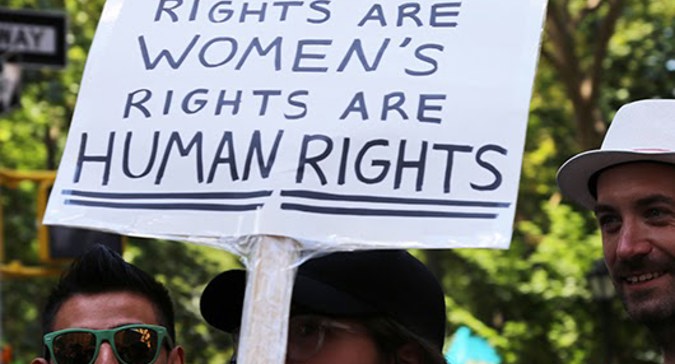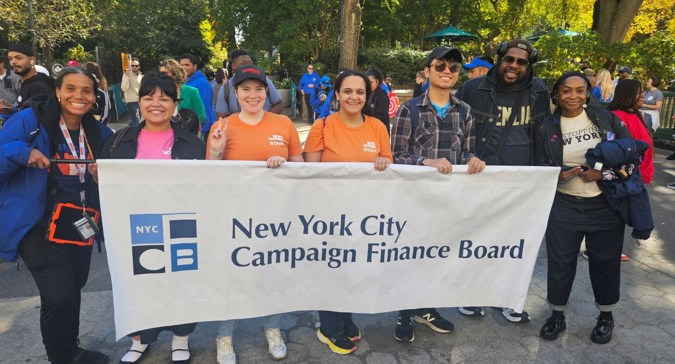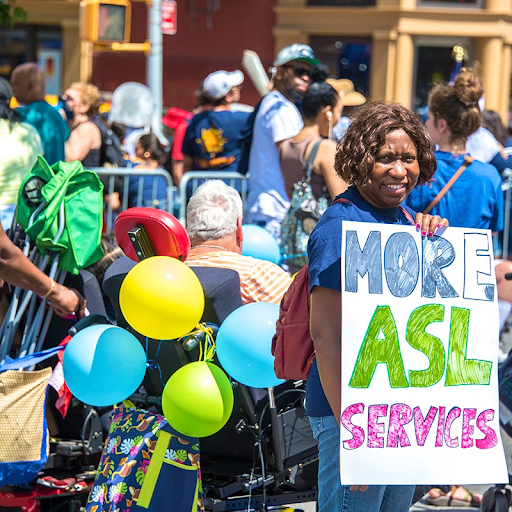4 दिसंबर 2024
मतदान में पहुंच कैसे हासिल की जा सकती है? इसकी शुरुआत न्यायोचित पहुँच के अवरोधों को समझ कर होती है।
इस देश में समानता हासिल करने के लिए अक्षमता वाले लोगों के संघर्ष के इतिहास, NYC में अक्षमता समुदाय की स्थिति और सभी के लिए मतदान को अधिक पहुंचक्षम बनाने के लिए उठाए गए कदमों को समझ कर हम इस शहर में और इससे आगे एक अधिक पहुंचक्षम भविष्य के लिए किस चीज़ की ज़रूरत है इसका पूर्वानुमान लगा सकते हैं।
एक छोटा इतिहास: 504 Sit-In का महत्व
1973 का रिहेबिलिटेशन ऐक्ट (Rehabilitation Act) अक्षमता के आधार पर भेदभाव को प्रतिबंधित करने वाला अपनी तरह का पहला कानून था। कानूनने अक्षमता की परिभाषा इस रूप में की थी “कोई भी व्यक्ति (A) जिसे कोई शारीरिक या मानसिक असमर्थता है, जो ऐसे व्यक्ति की एक या अधिक जीवन से संबंधित मुख्य गतिविधि को सीमित कर देती है, (B) जिसको ऐसी असमर्थता होने का रिकॉर्ड हो, या (C) जिसे ऐसी बाधा होना माना जाता है”। अक्षमता वाले अमेरिकन अधिनियम (Americans with Disabilities Act, ADA), जो 1990 में कानून बन गया, वह बाद में इस भाषा का उपयोग परिवर्तन के आधार के रूप में करेगा, और “अक्षम” के बदले “बाधित” का उपयोग करने लगेगा।
रिहेबिलिटेशन ऐक्ट का खंड 504 1973 में कानून के रूप में हस्ताक्षरित हुआ (हालाँकि दो बार वीटो होने के बाद)। लेकिन उसे तत्काल और पूरी तरह से लागू नहीं किया गया था, जिससे अक्षमता वाले लोग रहने की आवश्यक जगहों और सार्वजनिक सेवाओं तक पहुंच के बिना रह गए थे। इसे चार वर्षों तक लागू नहीं किया गया। यह मुख्यतः व्यवसायों और संगठनों द्वारा खंड 504 लागू करने के खिलाफ लॉबीइंग करने के कारण था, जिसके लिए उनकी दलील यह थी कि पहुंच लागू करना या संघीय निधियन को खो देना कष्टदायक और अनुचित था।
"504 Sit-in” (सिट-इन) नाम के 1977 के ऐतिहासिक विरोध के दौरान, अक्षमताओं वाले लोगों के एक समूह ने कई शहरों में सिट-इन विरोध करके अधिक पहुंच और अक्षमताओं वाले लोगों के लिए रहने की जगहों की मांग की। किसी संघीय इमारत पर सबसे लंबी अवधि तक कब्ज़ा 25 दिन तक सैन फ्रांसिस्को में था। इस विरोध के कारण अमेरिका में अक्षमता अधिकारों की प्रगति हुई और अंततः भावी कानूनों का मार्ग प्रशस्त करने में मदद मिली।
इस बीच, जहाँ अक्षमता वाले लोगों के पास मताधिकार था, ऐसे अवरोध अब भी थे जिनकी वजह से चुनाव के दिन मौजूद रहना और वोट देना मुश्किल या नामुमकिन था। लेकिन जब 1984 का वरिष्ठ नागरिकों और अक्षम व्यक्तियों के लिए मतदान को पहुंच कानून (Voting Accessibility for the Elderly and Handicapped Act) पारित किया गया, तो इसने संघीय चुनावों में पहुंच योग्य मतदान स्थल या चुनाव के दिन पर मतदान करने के वैकल्पिक तरीकों को आवश्यक बना कर अंतर को पाट लिया।
हाल के वर्षों में 2009 में लागू किए गए रोज़ा के कानून (Rosa’s Law) ने बौद्धिक अक्षमता वाले लोगों को परिभाषित करने के लिए “रिटार्डेशन” शब्द को बदला है और उसके उपयोग को निंदित किया है। यह सभा में एक मत से पारित हो गया। इस कानून के पारित होने ने शब्दों के अपमानजनक रूप में उपयोग करने की स्वीकृति और अक्षमता वाले लोगों के लिए नज़रिए को बदलने के प्रति समर्पण का संकेत दिया है। शब्द महत्वपूर्ण हैं। एक समुदाय के रूप में हमने अक्षमता वाले लोगों को नियंत्रित करने या उनका मज़ाक उड़ाने के लिए भाषा के उपयोग को चुनौती देने और इन शब्दों के उपयोग की सार्वजनिक समझ में परिवर्तन को प्रोत्साहन देने की दिशा में बहुत बड़े कदम उठाए हैं।
शब्द महत्वपूर्ण हैं। एक समुदाय के रूप में हमने अक्षमता वाले लोगों को नियंत्रित करने या उनका मज़ाक उड़ाने के लिए भाषा के उपयोग को चुनौती देने और इन शब्दों के उपयोग की सार्वजनिक समझ में परिवर्तन को प्रोत्साहन देने की दिशा में बहुत बड़े कदम उठाए हैं।

2024 की अक्षमता प्राइड परेड (Disability Pride Parade) में जा रहा कोई व्यक्ति (अक्षमता प्राइड परेड के सौजन्य से)
NYC में और उससे आगे अक्षमता समुदाय
अक्षमताओं वाले लोगों के लिए मेयर का कार्यालय (Mayor’s Office for People With Disabilities) के अनुसार 1 मिलियन से अधिक, हर 6 में से लगभग 1 न्यूयॉर्क निवासी अक्षमता वाला होने के रूप में पहचान करता है। इस आश्चर्यजनक आँकड़े के बावजूद, Inevitable Foundation रीसर्च इन्स्टीट्यूट, के एक सैंपल सर्वे के अनुसार अक्षमता वाले या बिना के 66% लोग सहमत हुए कि फिल्म या मीडिया में अक्षमता वाले लोगों का बहुत कम प्रतिनिधित्व है।
पर दुख की बात है कि यही सामान्य बात है। ज्यादातर निजी और सार्वजनिक स्थान अक्षमता वाले लोगों को शामिल करने के लिए नहीं बनाए गए हैं। परिणाम? अक्षमता वाले लोग ऐसे स्थानों पर नहीं जा सकते हैं। सक्षम व्यक्ति मान लेते हैं कि अक्षमता वाले लोगों की या तो इन स्थानों में रुचि नहीं है या वे इनमें मौजूद ही नहीं होते हैं। और इसलिए, यह स्थान गैरपहुँचक्षम ही बना हुआ है। गैरपहुँचक्षमता एक चक्र है।
क्या आपको पता था? न्यूयॉर्क नगर परिषद के अनुसार, 283 गैर-पहुंचयोग्य MTA स्टेशन हैं, जिनके लिए कोई वर्तमान निधियन योजनाएं नहीं हैं। और 73% एलिवेटर सेवारत नहीं हैं। इसके अलावा, 96% MTA वेबसाइट्स वेब कॉन्टेंट पहुंच मार्गदर्शिका (Web Content Accessibility Guidelines, WCAG) वर्शन 2.1 का अनुपालन नहीं करती हैं।
अक्षमता वाले लोग जिनका सामना करते हैं उन अवरोधों की पाँच श्रेणियाँ हैं: भौतिक,प्रणालीगत, अभिवृत्तिक, टेक्नोलॉजी संबंधी और संचार संबंधी। अवरोधों के उदाहरणों में प्रवेश द्वार में सीढ़ियाँ (भौतिक), स्टीरियोटाइप (अभिवृत्तिक), पुराने कानून में अपमानजनक भाषा (प्रणालीगत), पहुंच योग्य न हो ऐसी वेबसाइट (टेक्नोलॉजी संबंधी) या वीडियो पर कैप्शन की नामौजूदगी (संचार संबंधी)।
इसके तरीकों के बावजूद यह बेहतर हो सकता है, 22 राज्यों में से डिस्ट्रिक्ट ऑफ कोलंबिया के साथ न्यूयॉर्क एकमात्र राज्य है जिसमें मानसिक अक्षमता चुनाव कानून है। [1] NYS चुनाव कानून § 5-106(6) कहता है कि जिन लोगों को कोर्ट के आदेश के द्वारा अक्षम करार दिया गया है, उन्हें मतदान करने का अधिकार नहीं होगा। जब कोई कोर्ट तय करता है कि किसी विकास संबंधी विकार (Developmental Disorder, DD) वाला व्यक्ति अक्षम है, तब वह उन्हें उनके मतदान करने के संवैधानिक अधिकार से वंचित करता है और इस रूढ़िवादी मान्यता का समर्थन करता है कि DD वाले लोगों के पास अपने खुद के निर्णय लेने की क्षमता नहीं है।
NYC में मतदान को पहुंच
मतदान एक मूलभूत अधिकार है। वास्तव में यह संविधान में 15वाँ, 19वाँ, 24वाँ और 26वाँ अधिकार है। अक्षमता वाले व्यक्ति इस देश के हर नागरिक को प्रदान किए जा रहे समान अधिकारों और स्वतंत्रताओं का आनंद उठाना चाहते हैं।
The Center for the Independence of the Disabled (अक्षम व्यक्तियों की स्वतंत्रता के लिए केंद्र) द्वारा किए गए एक सर्वे में पाया गया कि अक्षमता वाले लोगों के लिए पास पड़ोस के मतदान स्थलों पर प्रवेश पाना भी एक बड़ा अवरोध बनता है।
NYC में कुल 64% मतदाता साइट्स में विकास संबंधी अक्षमताओं द्वारा पहचाने गए एक या अधिक पहुंच को अवरोध हैं। लेकिन अक्षमता वाले व्यक्तियों के लिए मतदान को पहुंचक्षम बनाने के कई तरीके हैं। उदाहरण के लिए: शहर की कई एजेन्सियाँ 77 से ज्यादा मतदान स्थलों तक निःशुल्क परिवहन प्रदान करती हैं।
चुनाव बोर्ड (Board of Elections, BOE) की ADA इकाई यह सुनिश्चित करने को समर्पित है कि पाँचों बर के मतदान स्थल चुनाव के दिन सभी मतदाताओं के लिए और पूरे जल्दी मतदान के दौरान पहुंचक्षम रहें। वे सुनिश्चित करते हैं कि प्रत्येक मतदान स्थल पर कम से कम एक बैलट मार्किंग डिवाइस और एक ADA प्राइवसी पूछ इंस्टॉल किए हुए हो, ताकि सभी अपने मतपत्र को निजी और स्वतंत्र रूप से चिह्नित कर पाएं। उनके जल्दी मतदान के कार्यान्वयन ने मतदान करने को भी आसान बनाया है। माँग करने पर एक पहुँच योग्य डाक द्वारा मतदान के लिए पहुंचक्षम मतपत्र भी उपलब्ध ह।
इसके अलावा, कई स्वतंत्र और नगर निकाय, जिनमें CFB शामिल है, मौजूदा अवरोधों को स्वीकार करके और जब संभव हो अस्थायी पहुंच प्रदान करके, मतदाता शिक्षा बढ़ाने के लिए प्रचार करके और मतदाता पहुंच के लिए अवगतता बढ़ाने के लिए शैक्षिक अवसर या प्रशिक्षण प्रदान करके मतदान स्थलों की पहुंच को संबोधित करने के लिए कार्य कर रहे हैं। मतदान को पहुंचक्षम बनाने में सफलता का बड़ा हिस्सा केवल मौजूद रह कर सहयोगी बनना है। हम स्वयं सेवा करते हैं और अक्षमता समुदाय द्वारा और उनके लिए प्रायोजित कार्यक्रमों में मौजूद रहते हैं ताकि हम सुन कर जहाँ ज़रूरत हो वहाँ कार्रवाई कर सकें।
मतदान को पहुंचक्षम बनाने में सफलता का बड़ा हिस्सा केवल मौजूद रह कर सहयोगी बनना है। हम स्वयं सेवा करते हैं और अक्षमता समुदाय द्वारा और उनके लिए प्रायोजित कार्यक्रमों में मौजूद रहते हैं ताकि हम सुन कर जहाँ ज़रूरत हो वहाँ कार्रवाई कर सकें।
CFB का पहुंच प्लान
अक्षमता वाले लोगों के लिए मेयर के कार्यालय और स्थानीय कानून 12 के अनुसार CFB ने विस्तृत पंच-वर्षीय पहुंच योजना बनाई है ताकि हम मतदाताओं की श्रेष्ठ सेवा कर सकें। पहुंच के आवश्यक प्रकार के आधार पर हमारी पहुंच के पहलुओं को संबोधित करने की योजना है: अधिक न्यायोचित CFB बनाने के लिए भौतिक, डिजिटल, प्रोग्रामेटिक, संचार और कार्यस्थल के क्षेत्रों में हम कर सकें ऐसे सुधार करके। यह योजना कार्य करने को समर्पित है: आंतरिक और बाहरी तौर पर एक अधिक पहुंचयोग्य अनुभव बनाने के लिए हम जो कर सकते हैं।
CFB की पहुंच योजना सुधार के लिए वास्तविक परिपेक्ष्य और आइडिया देती है। यह मतदाताओं के लिए शुरु से लेकर अंत तक एक पहुंच योग्य पथ बनाने के लिए प्रतिबद्धता का मूर्त स्वरूप है। यह करने के लिए, हमने लोगों के योजना को देखने और उस पर समीक्षा करने के लिए स्थान आयोजित किया ताकि सुनिश्चित हो सके कि हम हर चरण में समुदाय को ध्यान में रख कर विकास कर रहे हैं। संचार बहुत महत्वपूर्ण है और बिना समुदाय के साथ उस तार के बिना, हम सीधे हमारे स्थानीय लोकतंत्र को अधिक खुला, पारदर्शी और समानता भरा बनाने के अपनी एजेन्सी के मिशन में विफल होंगे।
पर यह तो बस एक कदम है। पहुंच के प्रति चेकबॉक्स में निशान लगाने का अभिगम नहीं होना चाहिए। हमें कम से कम लोगों को किस चीज़ की ज़रूरत है इसे सुनने और उसके निहितार्थ को समझने का प्रयास करना चाहिए। पहुंच एक बार किया जाने वाला समाधान नहीं है — यह समभाव और समझ की आवश्यकता रखने वाला जारी संवाद है।

डिसेबिलिटी प्राइड परेड 2024 में CFB कर्मचारी सदस्य और स्वयंसेवक।




